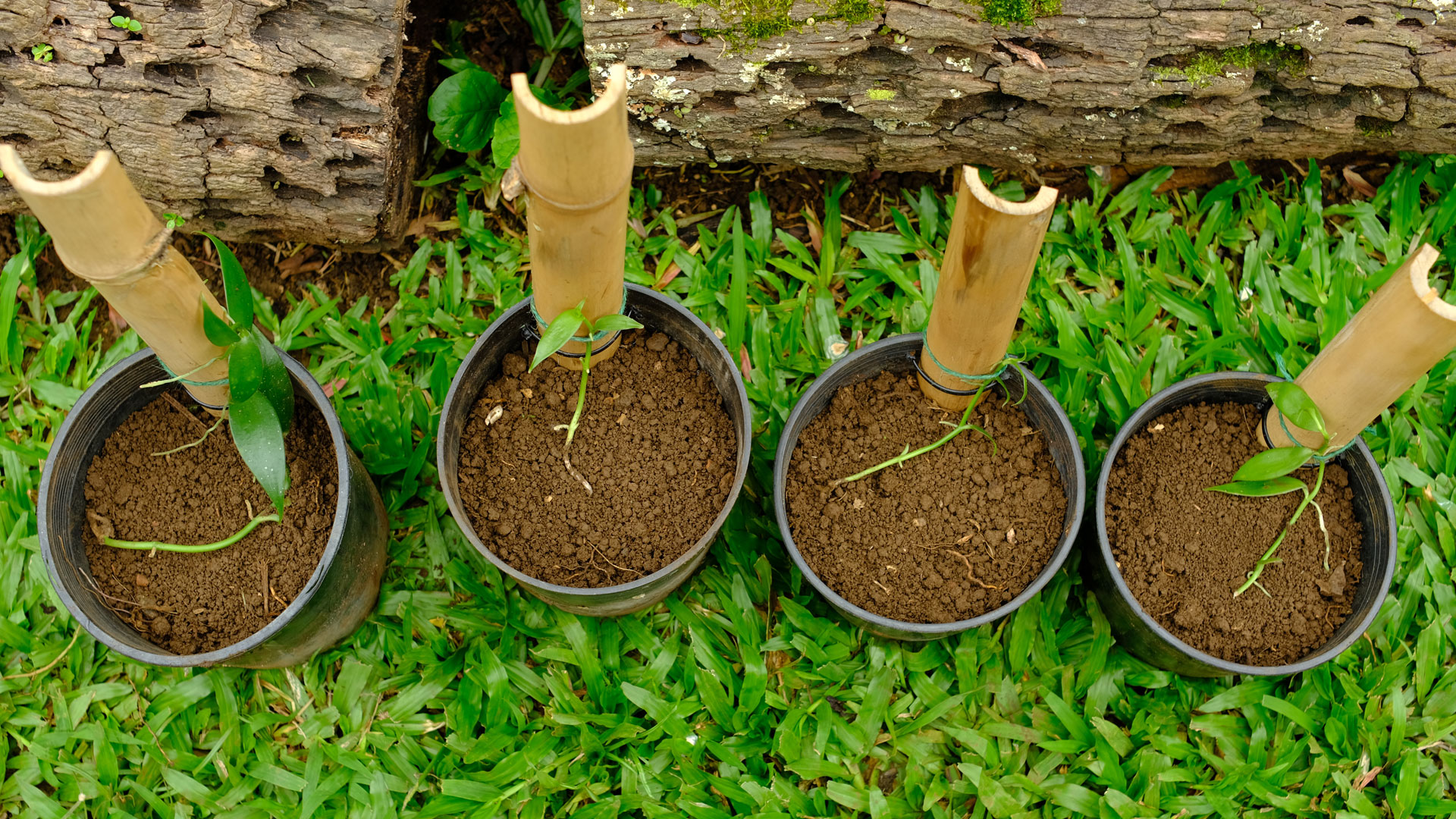
I occasionally come across new seedlings in the vanillery. We’ve written about this before, it’s something that happens spontaneously from time to time. Pods are left on the vine by accident, they ripen and drop their seeds. If the conditions are right, some of the seeds sprout.
A few weeks ago, when I was in the vanillery doing a general prune with a volunteer named Jacque, I came across several seedling deep under a dense section of vines. (Jacque is a PhD student in Plant and Environmental Sciences and while visiting the island, offered to do some volunteer work for us…and that sure was a fun and productive day!) Well, I took note of the location with the intention of moving the seedlings to pots so they can get a bit bigger before I plant them out in the new vanillery.
This is How We Pot Up the Seedlings
A vanilla seedling is a delicate little thing, but it’s going to get a lot bigger and we don’t want to disturb it while it’s growing, so we build it a place that is protected, but also has a structure it can wrap its little tendrils around. Here you can see the special pots I built for them.

We take a small plastic pot and zipstrap a sizeable stick of bamboo to it. It’s counterbalanced with a couple of large rocks in the bottom of the pot. Vanilla doesn’t need much soil, so the size of the pot and volume of soil is not too important. What is important is giving the vine a stable place to get started. There’s not a lot of vertical height to the support, that’s because when the vine has reached the top, it will be ready to get planted out.
For the soil, we fill it 3/4 full with native soil (mined in a forested area), then top that with soil from the vanillery. The thinking there is that the vanillery soil will contain compatible biota and most importantly, specific mycorrhizae essential to the vanilla roots’ uptake of nutrients.

The seedlings are placed on the soil and gently tied to the bamboo. The growing area is then covered with leafy mulch, providing a shady, moist environment for root development.
The potted seedlings are placed under a tree where the light is good, but shaded from the sun. If everything goes right, the seedlings will continue to grow and begin climbing up the bamboo support. When the plants are strong and reaching the top of the support, we put the whole thing into the vanillery without transplanting, next to a bamboo column for it to grow on. There is a picture of this at the bottom.




This is such good information, (as all of your information is) thank you so much for sharing your experience and knowledge to help give the rest of us more vital insight, for us who farm at home, either as a hobby or as a crop to sell. Mahalo so much from fellow vanilla farmers on the East side of the Big Island of Hawaii.
Ps: I especially look for any and all information on the curing process. Do you by chance have a book for sale on curing? It’s so tricky when we can get weeks of rain during this time. I will keep checking your wonderful website here regardless, but I was curious to know if you do. Mahalo, Tamara
Hi Tamara,
I like your idea, hadn’t thought about it, so maybe I will!
I am so glad to have found your website. I live in south Florida and have been growing vanilla for several years and have had some success growing vanilla beans.
This year however I have a very large harvest of beans not quite ripe yet. Finishing the beans has always been somewhat of a mystery until now that you have shared your knowledge. I am very excited knowing that I now have very specific instructions on how to finish my large harvest thanks to you!
I have ordered a reptile mat with a temperature sensor to put in my cooler and my air-fryer also doubles as a dehydrator.
I am so grateful!
Happy to share what I have learned, good luck with curing your harvest!
Hi I have what looks like roots coming out of my vanilla beans? Is this possible and will turn into a vine?
Yes, that is curious, I have never seen that…do you have a picture?